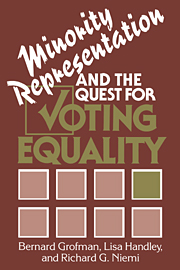Book contents
- Frontmatter
- Contents
- Acknowledgments
- List of Tables
- Introduction
- 1 The Right to Vote and the Right to Representation
- 2 The Evolution of a Vote Dilution Standard Through 1986
- 3 The Vote Dilution Standard in the Post-Gingles Era: Clarifications and Complications in the Lower Courts
- 4 Defining and Measuring Racially Polarized Voting and Other Elements of the Totality of the Circumstances
- 5 Vote Dilution in Single-Member Districts and Other Issues of the 1990s
- 6 The Voting Rights Act and the Realistic Politics of Second Best: An Optimistic Look to the Future
- Notes
- References
- Index of cases
- Index
1 - The Right to Vote and the Right to Representation
Published online by Cambridge University Press: 18 March 2010
- Frontmatter
- Contents
- Acknowledgments
- List of Tables
- Introduction
- 1 The Right to Vote and the Right to Representation
- 2 The Evolution of a Vote Dilution Standard Through 1986
- 3 The Vote Dilution Standard in the Post-Gingles Era: Clarifications and Complications in the Lower Courts
- 4 Defining and Measuring Racially Polarized Voting and Other Elements of the Totality of the Circumstances
- 5 Vote Dilution in Single-Member Districts and Other Issues of the 1990s
- 6 The Voting Rights Act and the Realistic Politics of Second Best: An Optimistic Look to the Future
- Notes
- References
- Index of cases
- Index
Summary
Our book is chiefly about the post–1965 era and about representation, as opposed to registration or turnout. However, the rationale for, as well as the nature of, recent and current efforts to protect minority voting rights cannot be understood without an awareness of the history of minority disfranchisement, especially black disfranchisement in the South. The Voting Rights Act of 1965 and the long line of litigation that forms its lineage can be understood only in the context of the failure of the previous hundred years to establish a secure basis for the right to vote. Thus we begin with a brief overview of that troubling history. We then describe the passage of the act itself and its initial extensions and expansion. Finally, we distinguish between voting and representation and raise a number of questions about the current and future operationalization of the concept of nondilution of minority votes. This distinction will serve as a backdrop for the remainder of the book.
The two-hundred-year struggle for minority voting rights
Before the Civil War, black men could vote in only six northern states; black women, of course, were denied the franchise in all states. After the war, the right to vote was extended to most adult males in the seceding states. Southern states were required by the Military Reconstruction Act of 1867 to adopt new constitutions granting universal male suffrage, regardless of race, as a condition for readmission to the Union.
Information
- Type
- Chapter
- Information
- Publisher: Cambridge University PressPrint publication year: 1992
